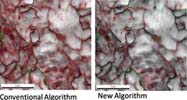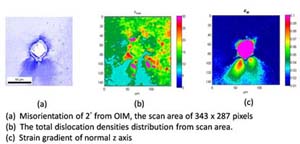Laboratory for Material Texture
EBSD Analysis Techniques
Basis of EBSD

The backscattered electron illuminated on the specimen would interacted with the crystal within the interaction volume and generated a diffraction pattern, Kikuchi pattern. Many crystallographic information such as : lattice structure, crystal orientation can be deconvoluted from the Kikuchi pattern. Statistical texture quantities could also be gathered from the data by scanning over areas.
I.High resolution EBSD (HR-EBSD)
- Enhance the accuracy of orientation identification
- Improve the angular accuracy of the EBSD
- Improve the spatial resolution of the EBSD

Typically, higher scanning rate or deformed sample would worsen the angular accuracy. In the left photo, the subgrain boundary(red lines) is not very clear identified. With the aid of new algorithm, localization of subgrain boundaries would be possible and the angular accuracy could be recovered from a fast scanning experiments.
II.Novel analysis techniques of EBSD
1. Dislocation density tensor
The geometrically necessary dislocation (GND) density tensor is determined from the raw data of EBSD in which Schmid Factor for a general stress field was used. The total dislocation density is around 0.7~2.5 X 1015 cm-2 (Fig.b). The high dislocation density shows the area with large misoreintation angle (Fig.a).
2. EBSD-based Micro-strain
EBSD technique integrated with the digital image correlation (DIC) is used to investigate the area in the vicinity of an indenter. The strain distribution shows more straining around the indenter and an anisotropic distribution.




